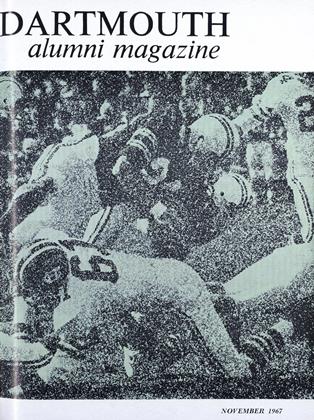DR. JOHN L. NORRIS '25 has spent 26 years in association with Alcoholics Anonymous trying "to do something for the poor guy who can't drink."
His interest in alcoholism, growing out of his job as Associate Medical Director for the Eastman Kodak Company, has won him recognition, marked most recently by the dedication of a clinic in his name at Rochester State Hospital. The plaque reads:
"In appreciation of, and gratitude for, his pioneer work, painstaking research, and sustained effort in the treatment of alchoholism. . . . The lives of many are forever indebted to his great interest and compassion for their need."
A man with a social conscience, he is national co-chairman of the Dartmouth Medical School fund drive and chairman of Governor Nelson Rockefeller's Advisory Council on Alcohol- ism. He became involved with AA when a patient he was treating for the disease asked him to attend a meeting with him. Since 1954 the doctor has been a trustee of AA and is now chairman of the board.
"One reason AA succeeds is because of the extent to which these people are willing to help others and consider it a favor that they be asked to help," he says.
Its companion associations, Al Anon for spouses and Al Ateen for teenagers, also draw praise from Dr. Norris. "We don't usually have just sick men, but sick families," he says.
Mild-mannered, soft spoken, and precise, Dr. Norris, a non-alcoholic, deals with alcoholism as a medical rather than a moral problem. He believes that medically there is a difference between the potential alcoholic and non-alcoholic. But he discredits most general conceptions about alcoholism. "The one generalization I will make is that all generalizations are bad," he says.
"We're up against the association of the word alcoholism with Skid Row. In my experience I've found that alcoholics are fine people," he says and mentions that there is a case before the Supreme Court which would, in effect, legally treat alcoholism as a disease rather than a crime.
He cites prejudice even in the medi- cal profession. Before the last ten years it was difficult to get a hospital to treat an alcoholic for the disease. He was usually admitted for something else and doctors frequently gave orders to "kick the bum out" when a bed was needed for "someone really sick."
Dr. Norris speaks of "engineering a crisis" before an alcoholic will get help. This may be done by the man himself or can be brought about by a confrontation with his supervisor, family, minister, or physician. He emphasizes "the right person," but adds, "This can save a man ten or fifteen years of hell."
"If people would limit themselves to a couple of drinks and never drink on an empty stomach," he claims, "we wouldn't have such problems with alcoholism."
He sees similar problems arising with the increasing use of drugs and warns of the danger of combining alcohol and sedatives which produces confusing effects of excitement and sedation. Many deaths listed as suicides are, according to him, the result of an accidental overdose of sleeping pills taken in combination with liquor.
Recently Dr. Norris has been encouraged by the kind of interest in alcoholism which prompted a special division to be created in the Department of Health, Education and Welfare. New York State is seeking to establish an institution for the study of alcoholism and now has eight in-patient units for alcoholism in its mental hospitals.
"Disappointments and frustrations are frequent," Dr. Norris says. "Successes can be more frequent and are very rewarding."
 View Full Issue
View Full Issue
More From This Issue
-
 Feature
FeatureA Fulbright Professor in France
November 1967 By FRANCIS E. MERRILL '26, -
 Feature
FeatureMt. McKinley Conquered
November 1967 By Anthony H. Horan '61 -
 Feature
FeatureFINAL REPORT 1966-1967
November 1967 By RALPH LAZARUS '35 -
 Feature
FeatureTHE BETRAYAL OF IDEALISM
November 1967 -
 Feature
FeatureThe Topic: Third Century Fund
November 1967 -
 Article
ArticleWith tine Big Green Teams
November 1967
Article
-
 Article
ArticleUndergraduate Editor
MAY 1931 -
 Article
ArticleGradus Ad Parnassian
January 1938 -
 Article
ArticleNew High for 25th Reunion Gift
July 1962 -
 Article
ArticleGEOGRAPHICAL DISTRIBUTION OF DARTMOUTH STUDENTS
May, 1923 By DON W. MOORE '25 -
 Article
ArticleLook who’s taLking
NOVEMBER | DECEMBER 2013 By Lauren Vespoli ’13 -
 Article
ArticleBig Green Teams
March 1941 By Whitey Fuller '37

